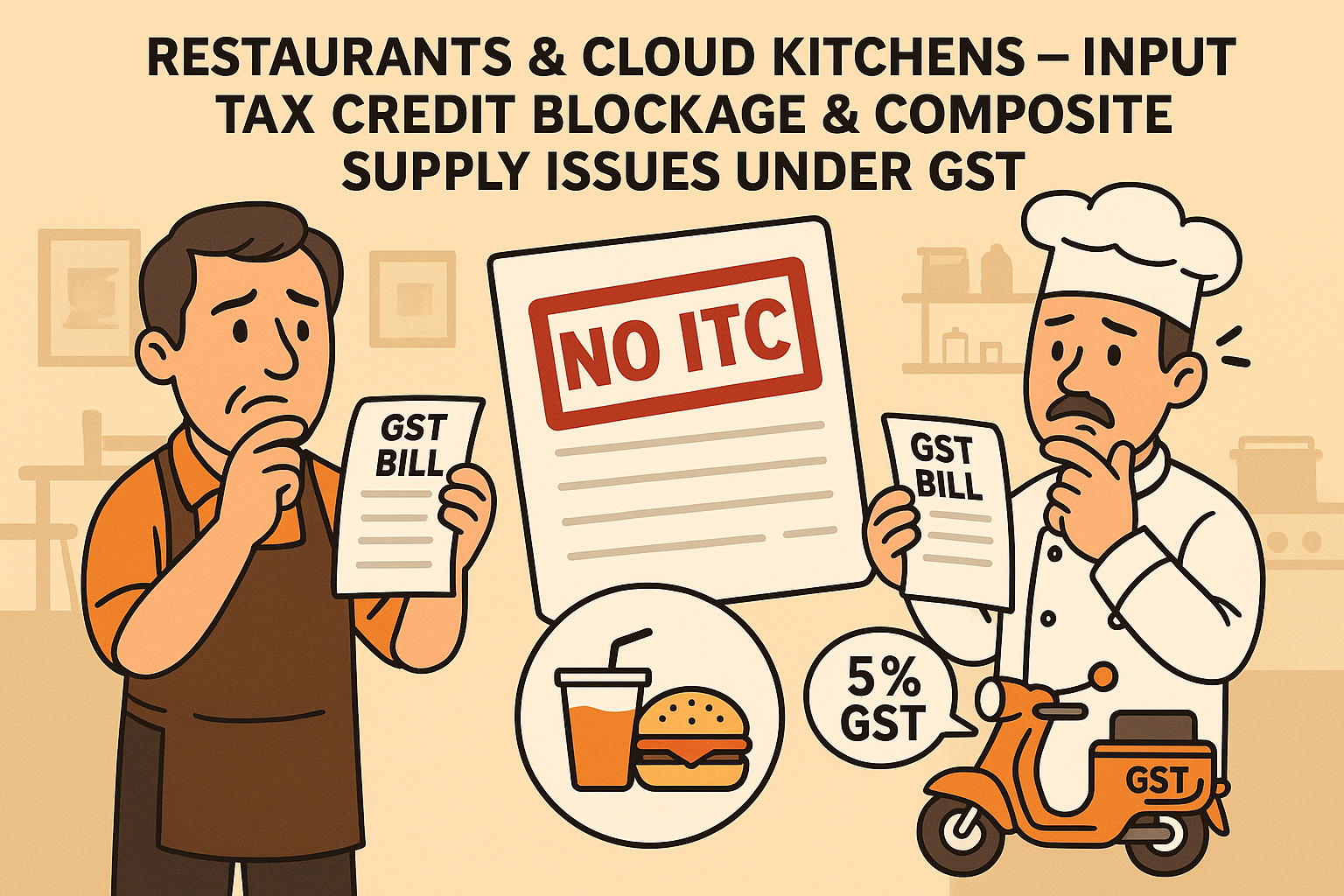Restaurants and cloud kitchens have become one of the fastest-growing segments in India’s food industry.
With the support of food delivery platforms like Zomato, Swiggy, and Uber Eats (now merged), even small kitchens can reach thousands of customers.
However, GST has brought specific challenges for this sector — mainly Input Tax Credit Blockage and classification disputes due to composite supply.
These two issues directly impact:
- Business margins
- Pricing strategies
- GST compliance risk
Table of Contents
1. GST Rate Applicable to Restaurants & Cloud Kitchens
Under GST, restaurant services are charged at 5% GST without ITC, as per:
- Notification No. 46/2017 – Central Tax (Rate) dated 14.11.2017 (effective from 01.01.2018).
- Covers: Dine-in, Takeaway, and Cloud Kitchens.
- No ITC allowed on goods or services used for providing these supplies.
Important Note:
Cloud kitchens are treated at par with physical restaurants for GST purposes. Even if there is no seating facility and the food is only delivered, the GST treatment remains the same.
Relevant Sections of GST Law:
- Section 17(5) of the CGST Act, 2017 – Blocked credit.
- Entry 7(i) of Notification No. 11/2017-Central Tax (Rate) – GST rate schedule for restaurants.
2. What is Input Tax Credit Blockage?
Input Tax Credit allows businesses to reduce their GST liability by setting off the tax they have already paid on purchases.
For restaurants and cloud kitchens under the 5% scheme, ITC on:
- Raw materials (oil, spices, flour, vegetables)
- Beverages
- Kitchen equipment
- Rent, utilities, software subscriptions
- Packaging materials
is blocked.
Example:
- You buy raw materials worth ₹1,00,000 + GST 18% = ₹1,18,000.
- Normally, you could claim ₹18,000 as ITC.
- But under 5% GST without ITC, this ₹18,000 becomes a cost.
Why the Government Did This:
The GST Council reduced the rate from 18% to 5% to make eating out cheaper for customers, but to maintain revenue neutrality, they removed ITC for this category.
3. Composite Supply – The Big Confusion
Definition (Section 2(30) of CGST Act):
When two or more goods/services are naturally bundled and supplied together in the ordinary course of business, and one is the principal supply.
Impact on Restaurants & Cloud Kitchens:
If you supply food + delivery service + packaging in one order:
- Food is the principal supply.
- The whole order is taxed at 5% without ITC, even if delivery or packaging is taxable at a higher rate separately.
Relevant Sections:
- Section 8 of CGST Act – Tax on composite and mixed supply.
4. Real-Life Scenarios
Case 1 – Delivery Charges Dispute
A cloud kitchen charges ₹200 for food + ₹40 for delivery. They put 5% GST on food and 18% GST on delivery.
GST officer argues it’s a composite supply and applies 5% on total ₹240 without ITC.
Case 2 – Packaging Material Sale
Restaurant sells a food item with a branded container separately billed at 18% GST.
If container is naturally part of serving food, entire amount gets taxed at 5% without ITC.
Case 3 – Combo Offers
Pizza + Coke combo sold for ₹300. Even if Coke alone is 28% GST, as part of the combo it becomes 5% without ITC.
5. Practical Impact
- Higher costs – Loss of ITC on rent, electricity, marketing expenses, kitchen equipment, software.
- Lower margins – Businesses need to adjust menu pricing to cover ITC loss.
- Litigation risk – Composite supply disputes during GST audit.
- Operational complexity – Maintaining multiple tax categories becomes risky.
6. How to Reduce GST Burden – Expert Suggestions
- Price Adjustment – Factor ITC loss into your pricing model.
- Separate Supply Structuring – If possible and justified, separate certain services (e.g., event catering, pure delivery service) to claim ITC.
- Record Keeping – Maintain detailed invoices, contracts, and proof for non-composite supply claims.
- Professional Advice – Take GST consultation with taxgiveindia.com before introducing new services or combo offers.
7. Relevant GST Sections & Notifications
- Section 17(5) of CGST Act – Blocked credits.
- Section 2(30) & Section 8 – Composite and mixed supplies.
- Notification No. 46/2017-Central Tax (Rate) – GST rates for restaurants.
- Notification No. 11/2017-Central Tax (Rate) – Service classification.
Conclusion
For restaurants and cloud kitchens, GST law is simple in rate but tricky in practice.
While 5% GST looks attractive for customers, the loss of ITC and composite supply complications make compliance a challenge.
Proper structuring, documentation, and periodic GST reviews can help businesses avoid costly disputes and maintain healthy margins.
